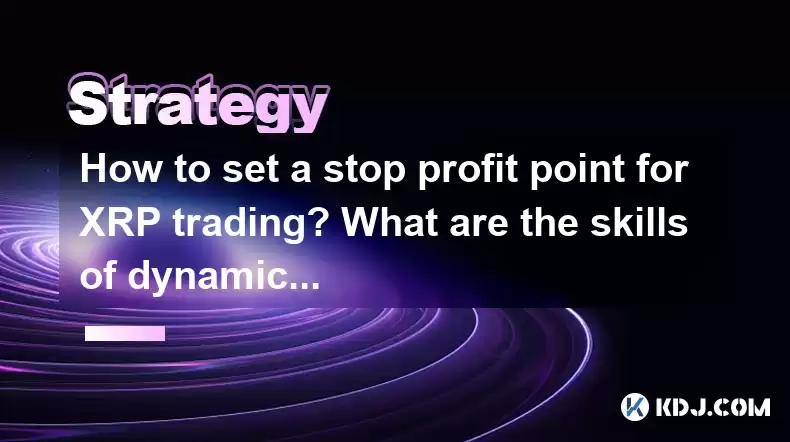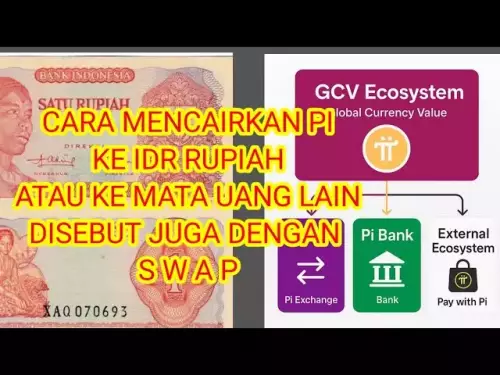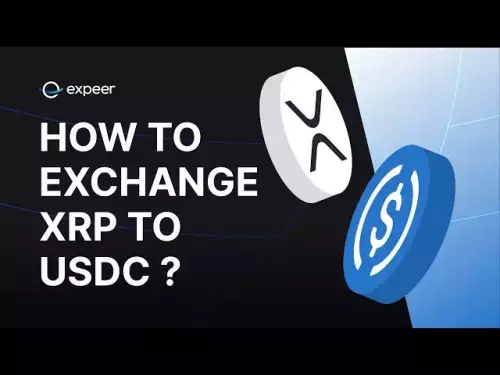-
 bitcoin
bitcoin $112715.707551 USD
-1.71% -
 ethereum
ethereum $4101.475385 USD
-3.01% -
 tether
tether $1.000644 USD
-0.02% -
 bnb
bnb $1207.619465 USD
-6.77% -
 xrp
xrp $2.501451 USD
-3.98% -
 solana
solana $202.947124 USD
-3.32% -
 usd-coin
usd-coin $1.000295 USD
0.04% -
 dogecoin
dogecoin $0.203884 USD
-4.47% -
 tron
tron $0.317154 USD
-1.72% -
 cardano
cardano $0.695009 USD
-4.43% -
 hyperliquid
hyperliquid $38.853961 USD
-8.23% -
 chainlink
chainlink $18.988674 USD
-4.64% -
 ethena-usde
ethena-usde $1.000233 USD
-0.03% -
 stellar
stellar $0.337050 USD
-3.63% -
 bitcoin-cash
bitcoin-cash $536.861728 USD
-1.28%
How to set a stop profit point for XRP trading? What are the skills of dynamic adjustment strategy
To trade XRP effectively, set a stop profit point to lock in gains and use dynamic adjustment to adapt to market changes, enhancing your trading strategy.
Apr 29, 2025 at 12:43 am

Trading XRP, like any other cryptocurrency, involves managing risks and maximizing profits. One of the key strategies traders use is setting a stop profit point, which helps lock in gains when the price of XRP reaches a predetermined level. Additionally, employing a dynamic adjustment strategy can enhance a trader's ability to adapt to market fluctuations. This article will guide you through the process of setting a stop profit point for XRP and discuss the skills required for a dynamic adjustment strategy.
Understanding Stop Profit Points
A stop profit point, also known as a take-profit order, is an order placed with a broker to buy or sell a security when it reaches a certain price. For XRP traders, this means setting a price level at which they want to sell their XRP to realize a profit. The primary goal is to ensure that gains are not eroded by sudden market downturns.
Setting a Stop Profit Point for XRP
To set a stop profit point for XRP, you will need to follow these steps:
Choose a Trading Platform: Select a reputable cryptocurrency exchange that supports XRP trading and offers the ability to set stop profit orders. Examples include Binance, Coinbase Pro, and Kraken.
Analyze the Market: Before setting your stop profit point, analyze the current market conditions. Look at the recent price movements, trading volume, and any news that might affect XRP's price.
Determine Your Profit Target: Decide on the profit level you are aiming for. This could be based on a percentage gain, a specific price level, or a technical indicator like resistance levels.
Set the Stop Profit Order: On your chosen trading platform, navigate to the XRP trading pair you are interested in. Look for the option to set a stop profit order. Enter the price at which you want to sell your XRP. For example, if you bought XRP at $0.50 and want to sell at $0.60, you would set your stop profit at $0.60.
Monitor and Adjust: Once your stop profit order is set, monitor the market closely. Be prepared to adjust your stop profit level if market conditions change.
Skills for Dynamic Adjustment Strategy
A dynamic adjustment strategy involves continuously modifying your trading parameters based on real-time market data. This approach requires a set of skills to be effective:
Technical Analysis Proficiency: Understanding technical indicators such as moving averages, RSI, and MACD can help you identify trends and potential reversal points. This knowledge is crucial for adjusting your stop profit levels dynamically.
Market Sentiment Awareness: Keeping an eye on market sentiment through social media, news, and forums can provide insights into potential price movements. Adjusting your stop profit based on sentiment can help you capitalize on market trends.
Risk Management: Effective risk management is essential for dynamic adjustment. This includes setting appropriate stop-loss orders to protect against significant losses and adjusting your position size based on your risk tolerance.
Adaptability: The ability to quickly adapt to changing market conditions is key. This means being willing to adjust your stop profit levels frequently based on new information and market movements.
Discipline: Maintaining discipline in sticking to your trading plan and not letting emotions drive your decisions is crucial. Dynamic adjustment requires a clear strategy and the discipline to follow it.
Implementing Dynamic Adjustment for XRP
To implement a dynamic adjustment strategy for XRP, follow these steps:
Set Initial Stop Profit: Start by setting an initial stop profit point based on your analysis and profit target.
Monitor Market Indicators: Use technical indicators to monitor XRP's price movements. For example, if the price breaks above a resistance level, you might consider raising your stop profit to lock in more gains.
Adjust Based on Sentiment: If there is positive news about XRP or a bullish sentiment in the market, you might adjust your stop profit higher to take advantage of the upward momentum.
Use Trailing Stops: Consider using trailing stop orders, which automatically adjust your stop profit level as the price moves in your favor. This can help you capture more profit while still protecting against downturns.
Review and Adjust Regularly: Regularly review your stop profit levels and adjust them based on new market data. This might mean lowering your stop profit if the market turns bearish or raising it if the bullish trend continues.
Tools and Resources for Dynamic Adjustment
Several tools and resources can aid in implementing a dynamic adjustment strategy for XRP trading:
Trading Bots: Automated trading bots can help execute dynamic adjustments based on predefined rules. Platforms like 3Commas and Cryptohopper offer such services.
Charting Software: Tools like TradingView and MetaTrader provide advanced charting capabilities and the ability to set custom alerts for price movements.
News Aggregators: Websites like CoinDesk and CryptoSlate can keep you updated on the latest news affecting XRP, helping you make informed adjustments.
Social Media and Forums: Platforms like Twitter and Reddit can provide real-time insights into market sentiment, which can be crucial for dynamic adjustments.
Practical Example of Dynamic Adjustment
Let's consider a practical example of how you might dynamically adjust your stop profit for XRP:
Initial Setup: You buy XRP at $0.50 and set an initial stop profit at $0.60.
Price Movement: The price of XRP rises to $0.55, and technical indicators suggest a strong bullish trend.
First Adjustment: You raise your stop profit to $0.65 to capture more potential gains.
Market Sentiment: Positive news about XRP's adoption by a major company boosts market sentiment.
Second Adjustment: You further raise your stop profit to $0.70 to take advantage of the bullish momentum.
Price Reversal: The price starts to show signs of a reversal, and you decide to lock in profits.
Final Adjustment: You lower your stop profit to $0.68 to ensure you capture some of the gains before a potential downturn.
Frequently Asked Questions
Q: Can I set multiple stop profit points for XRP trading?A: Yes, some trading platforms allow you to set multiple stop profit points for a single position. This can be useful for taking partial profits at different price levels.
Q: How often should I adjust my stop profit for XRP?A: The frequency of adjustments depends on your trading strategy and market volatility. In highly volatile markets, you might need to adjust your stop profit more frequently, while in stable markets, less frequent adjustments may be sufficient.
Q: What is the difference between a stop profit and a stop loss?A: A stop profit order is used to lock in profits by selling an asset when it reaches a certain price, while a stop loss order is used to limit losses by selling an asset when its price falls to a certain level.
Q: Can I use a stop profit order on all trading platforms?A: Not all trading platforms support stop profit orders. It's important to check the features of your chosen platform before setting up your trades.
Disclaimer:info@kdj.com
The information provided is not trading advice. kdj.com does not assume any responsibility for any investments made based on the information provided in this article. Cryptocurrencies are highly volatile and it is highly recommended that you invest with caution after thorough research!
If you believe that the content used on this website infringes your copyright, please contact us immediately (info@kdj.com) and we will delete it promptly.
- Meme Coin Mania: MoonBull, FLOKI, and SHIB – What's the Buzz?
- 2025-10-16 09:10:00
- Pepeto's Presale Success: Riding the Crypto Bull Run Wave
- 2025-10-16 08:30:01
- Secure Enclave, Flow, and Launch: What's the Buzz?
- 2025-10-16 08:30:01
- Crypto Technologies Blast Through: A New Era Dawns on the Digital Frontier
- 2025-10-16 08:30:01
- DeFi, RWA Tokenization, and Institutional Adoption: A New Era?
- 2025-10-16 06:50:01
- Coinbase vs. Binance: Navigating the BNB Listing Landscape
- 2025-10-16 06:40:01
Related knowledge

Practical parameter settings for a Bitcoin multi-timeframe moving average system
Sep 18,2025 at 10:54pm
Optimizing Timeframe Combinations for Bitcoin Trading1. Selecting appropriate timeframes is crucial when building a multi-timeframe moving average sys...

How can I filter out false breakouts in Dogecoin high-frequency trading?
Sep 22,2025 at 01:00am
Understanding False Breakouts in Dogecoin Trading1. A false breakout occurs when Dogecoin's price appears to move beyond a defined support or resistan...

Techniques for identifying tops and bottoms in the Bitcoin on-chain NVT model
Sep 20,2025 at 07:54pm
Understanding the NVT Model in Bitcoin Analysis1. The Network Value to Transactions (NVT) ratio is often described as the 'P/E ratio' of the cryptocur...

What does the surge in open interest in Bitcoincoin futures mean?
Sep 20,2025 at 11:18pm
Understanding the Surge in Dogecoin Futures Open Interest1. A surge in open interest within Dogecoin futures indicates a growing number of active cont...

How can I use the Ethereum USDT premium to gauge market sentiment?
Sep 18,2025 at 11:55pm
Understanding the Ethereum USDT Premium1. The Ethereum USDT premium refers to the price difference between USDT (Tether) traded on Ethereum-based plat...

What should I do if Ethereum staking yields decline?
Sep 20,2025 at 06:18am
Understanding the Causes Behind Declining Ethereum Staking Yields1. The Ethereum network transitioned to a proof-of-stake consensus mechanism with the...

Practical parameter settings for a Bitcoin multi-timeframe moving average system
Sep 18,2025 at 10:54pm
Optimizing Timeframe Combinations for Bitcoin Trading1. Selecting appropriate timeframes is crucial when building a multi-timeframe moving average sys...

How can I filter out false breakouts in Dogecoin high-frequency trading?
Sep 22,2025 at 01:00am
Understanding False Breakouts in Dogecoin Trading1. A false breakout occurs when Dogecoin's price appears to move beyond a defined support or resistan...

Techniques for identifying tops and bottoms in the Bitcoin on-chain NVT model
Sep 20,2025 at 07:54pm
Understanding the NVT Model in Bitcoin Analysis1. The Network Value to Transactions (NVT) ratio is often described as the 'P/E ratio' of the cryptocur...

What does the surge in open interest in Bitcoincoin futures mean?
Sep 20,2025 at 11:18pm
Understanding the Surge in Dogecoin Futures Open Interest1. A surge in open interest within Dogecoin futures indicates a growing number of active cont...

How can I use the Ethereum USDT premium to gauge market sentiment?
Sep 18,2025 at 11:55pm
Understanding the Ethereum USDT Premium1. The Ethereum USDT premium refers to the price difference between USDT (Tether) traded on Ethereum-based plat...

What should I do if Ethereum staking yields decline?
Sep 20,2025 at 06:18am
Understanding the Causes Behind Declining Ethereum Staking Yields1. The Ethereum network transitioned to a proof-of-stake consensus mechanism with the...
See all articles










































































